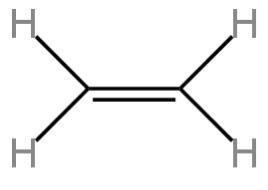
The angle between\[s{p^2}\]orbitals in ethylene is
A.\[90^\circ \]
B.\[120^\circ \]
C.\[180^\circ \]
D.\[109.5^\circ \]
Answer
224.7k+ views
Hint: Ethylene is a hydrocarbon that has the formula\[{C_2}{H_4}\] which is the simplest alkene.
The bond angle can be found by using VSEPR (valence shell electron pair repulsion theory).
Complete step by step solution:Ethylene also known as ethene is an alkene that is a hydrocarbon possessing a carbon-carbon double bond.
Hybridization is the combination of atomic orbitals to construct a unique set of equivalent orbitals called hybrid orbitals.
The shape formed by the hybridized orbitals is predicted by VSEPR theory.
VSEPR theory provides a basic idea about the shape of a molecule relying upon the electron pair present in the valence shell.
A molecule that undergoes\[s{p^2}\]hybridization, has one s orbital and one p orbital combined to form an sp2 hybridized orbital which has the same orbital energy as the s and p orbitals.
Here ethylene molecules undergo sp2 hybridization.
Carbon is the central atom of the molecule with electronic configuration \[1{s^2}2{s^2}2{p_x}^12{p_y}^1\].
Carbon extends its valency by moving one electron from 2s to 2pz orbital.
Now the final configuration of carbon becomes \[1{s^2}2{s^1}2{p_x}^12{p_y}^12{p_z}^1\] with valency 4.
One 2s orbital and two 2p orbitals of carbon undergo hybridization to form an\[s{p^2}\] hybridized orbital.
These hybridized orbitals overlap with the 1s orbital of four hydrogen atoms to form ethylene.
The remaining \[2{p_z}\] lies unhybridized and perpendicular to the plane of the \[s{p^2}\]hybridized orbital.
Hydrogen atoms are placed at\[120^\circ \] with the central metal atom to form a shape known as trigonal planar.

Image: Ethylene
So, the angle between \[s{p^2}\]orbitals in ethylene is \[120^\circ \].
So, option B is correct.
Note: Ethylene is a hormone that influences the ripening and flowering of many plants.
It is widely utilized to regulate freshness in horticulture and fruits.
The hydroformylation of ethylene gives propionaldehyde which is used for preparing propionic acid and n-propyl alcohol.
The bond angle can be found by using VSEPR (valence shell electron pair repulsion theory).
Complete step by step solution:Ethylene also known as ethene is an alkene that is a hydrocarbon possessing a carbon-carbon double bond.
Hybridization is the combination of atomic orbitals to construct a unique set of equivalent orbitals called hybrid orbitals.
The shape formed by the hybridized orbitals is predicted by VSEPR theory.
VSEPR theory provides a basic idea about the shape of a molecule relying upon the electron pair present in the valence shell.
A molecule that undergoes\[s{p^2}\]hybridization, has one s orbital and one p orbital combined to form an sp2 hybridized orbital which has the same orbital energy as the s and p orbitals.
Here ethylene molecules undergo sp2 hybridization.
Carbon is the central atom of the molecule with electronic configuration \[1{s^2}2{s^2}2{p_x}^12{p_y}^1\].
Carbon extends its valency by moving one electron from 2s to 2pz orbital.
Now the final configuration of carbon becomes \[1{s^2}2{s^1}2{p_x}^12{p_y}^12{p_z}^1\] with valency 4.
One 2s orbital and two 2p orbitals of carbon undergo hybridization to form an\[s{p^2}\] hybridized orbital.
These hybridized orbitals overlap with the 1s orbital of four hydrogen atoms to form ethylene.
The remaining \[2{p_z}\] lies unhybridized and perpendicular to the plane of the \[s{p^2}\]hybridized orbital.
Hydrogen atoms are placed at\[120^\circ \] with the central metal atom to form a shape known as trigonal planar.

Image: Ethylene
So, the angle between \[s{p^2}\]orbitals in ethylene is \[120^\circ \].
So, option B is correct.
Note: Ethylene is a hormone that influences the ripening and flowering of many plants.
It is widely utilized to regulate freshness in horticulture and fruits.
The hydroformylation of ethylene gives propionaldehyde which is used for preparing propionic acid and n-propyl alcohol.
Recently Updated Pages
JEE Main 2026 Session 1 Correction Window Started: Check Dates, Edit Link & Fees

JEE Isolation, Preparation and Properties of Non-metals Important Concepts and Tips for Exam Preparation

Isoelectronic Definition in Chemistry: Meaning, Examples & Trends

Ionisation Energy and Ionisation Potential Explained

Iodoform Reactions - Important Concepts and Tips for JEE

Introduction to Dimensions: Understanding the Basics

Trending doubts
JEE Main 2026: City Intimation Slip and Exam Dates Released, Application Form Closed, Syllabus & Eligibility

JEE Main 2026 Application Login: Direct Link, Registration, Form Fill, and Steps

Understanding the Angle of Deviation in a Prism

Hybridisation in Chemistry – Concept, Types & Applications

How to Convert a Galvanometer into an Ammeter or Voltmeter

Ideal and Non-Ideal Solutions Explained for Class 12 Chemistry

Other Pages
JEE Advanced Marks vs Ranks 2025: Understanding Category-wise Qualifying Marks and Previous Year Cut-offs

Thermodynamics Class 11 Chemistry Chapter 5 CBSE Notes - 2025-26

Organic Chemistry Some Basic Principles And Techniques Class 11 Chemistry Chapter 8 CBSE Notes - 2025-26

Hydrocarbons Class 11 Chemistry Chapter 9 CBSE Notes - 2025-26

JEE Advanced 2026 - Exam Date (Released), Syllabus, Registration, Eligibility, Preparation, and More

JEE Advanced 2026 - Exam Date (Released), Syllabus, Registration, Eligibility, Preparation, and More




